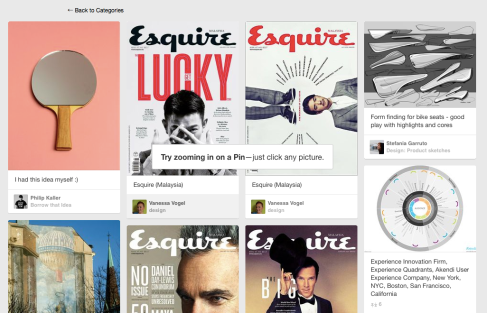Pinterest has captured the imagination of Internet users to become a top 10 social network in a matter of months. Not only is the speed of its rise fascinating, but the audience make up and its ability to drive traffic to participating sites have made it an important new opportunity — particularly for lifestyle brands. But how does it works? What are the best practices for marketing your business on Pinterest?
1. Set up your brand page and account. You’ll need an invite to Pinterest to join; but your social media or marketing department team members likely have an account from which they can invite you to set up your brand account.
2. Brand your account. Choose a user name that aligns with your brand. Upload your logo as your profile picture and fill out your profile so that users know it’s the brand account.
3. Create your initial pinboards. Think of the different types of collections that are relevant to your business and set up initial pinboards. Look at the featured accounts above for ideas on how to set up your first set of boards. You can start with just a few boards and expand as your engagement on Pinterest grows.
4. Seed your initial pinboards. Seed your initial boards with images from your websites and brands. These products will help establish what your brand presence is all about when users first visit your boards. Use images and products that are diverse.
5. Be consistent. Try to repin and add new content to your boards daily. The Pinterest stream moves quickly, so focused bursts will only been seen by a fraction of the people using the service.
6. Cross-promote your accounts. Jump-start your Pinterest following by announcing and sharing your new social account with your followers on other social media channels like Facebook and Twitter, and via email.
7. Get your employees involved. There’s a good chance your employees are already on Pinterest. Ask them to contribute to your pinboards and ask their feedback on how to make your brand account one worth following. By getting them involved they’ll help repin and share your content with their followers, as well as surface great content for you to repin and share.
8. Curating Interesting Pinboards. Unlike Facebook, Google+ and Twitter, Pinterest lacks ‘brand’ pages. Brands use standard accounts and therefore are represented as a brand only by their user name, logo and the boards they curate. Users who find a brand via a pinned item will often review the brand’s boards for interesting collections before making a determination to follow the brand. Pinboards should be sorted by category, theme or interest and contain a mix of brand products and curated products.
9. Avoiding Excessive Self-Promotion. Brands must share their own content in order to reap the traffic benefits of Pinterest. There are no hard and fast rules around the optimum mix of brand content vs. repinned content; but the general rule of thumb is to find some balance in what is shared.
10. Finding and Following Users. In order to build a following users must be aware of the brand presence on Pinterest. The easiest way to do this is to repin, like or comment on other user’s items. Repins, likes and follows generate email notifications to users, alerting them to your activity. This builds goodwill and also creates awareness of your brand account on Pinterest



